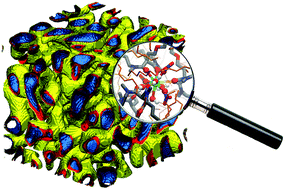The role of curvature effects in liquid–liquid extraction: assessing organic phase mesoscopic properties from MD simulations†
Abstract
The bending rigidity of small reverse aggregates involved in liquid–liquid extraction processes has been investigated by molecular dynamics simulations. Simulations of a common extractant (DMDOHEMA) with four hydrophobic chains in explicit solvent (n-heptane) and in vacuum have been performed to determine the effect of solvent penetration on film stiffness. Elastic film bending energy that is needed for mesoscopic modelling of transfer of species between complex fluids is harmonic in terms of curvature (Helfrich formalism) and the packing parameter only if the solvent is explicitly taken into account. In terms of the packing parameter of the real molecular film constituting the reverse water in oil aggregates and taking into account molecular volume, area and film thickness (that is in agreement with Tanford's model), the bending rigidity is calculated to be about 16 kBT per extractant molecule (about 40 kJ mol−1), which is smaller than the free energy of transfer from an isolated “monomer” molecule to a weak aggregate, but of the order of magnitude of the free energy of transfer used in liquid–liquid extraction processes.



 Please wait while we load your content...
Please wait while we load your content...